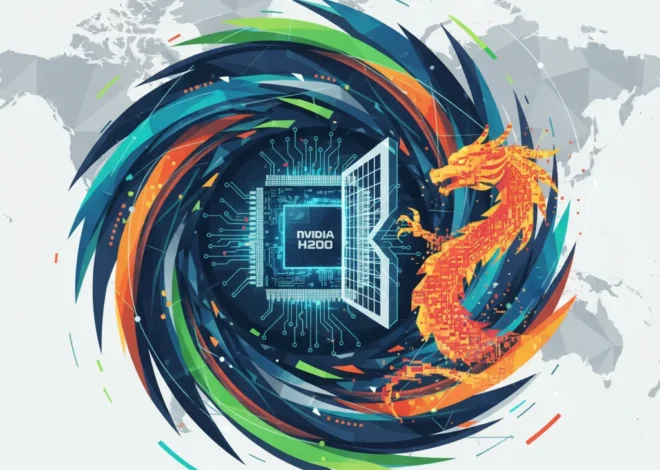
The Chip War’s New Front: Why China’s Olive Branch to Europe Could Reshape Global Markets
In the high-stakes world of global economics, the smallest components often cast the longest shadows. Semiconductors, the microscopic brains powering everything from our smartphones to our financial markets, have become the central battleground in a new era of geopolitical competition. Recently, a subtle but significant development emerged from this conflict: China has signaled a potential easing of its chip-related export controls aimed at Europe. This move, stemming from a dispute with the Netherlands, is far more than a simple trade concession. It’s a calculated maneuver with profound implications for the global economy, the stock market, and the future of international trade.
For investors, business leaders, and finance professionals, understanding the nuances of this “chip war” is no longer optional. It’s essential. This single development touches upon supply chain stability, corporate profitability, and the very structure of the global financial system. Is this a genuine de-escalation, or a strategic repositioning in a long-term conflict? Let’s dissect the situation and explore what it means for your portfolio, your business, and the broader economic landscape.
The Dutch Connection: A Geopolitical Chokepoint
To understand why this news is so critical, we must first look to a small country with an outsized impact on the global technology ecosystem: the Netherlands. It is home to ASML, a company that holds a monopoly on the production of extreme ultraviolet (EUV) lithography machines—the most advanced and complex tools required to manufacture cutting-edge semiconductors.
For years, the United States has been pressuring its allies, including the Netherlands, to restrict China’s access to this critical technology. The goal is to slow Beijing’s military modernization and technological advancement. In response to Dutch compliance with these restrictions, China retaliated. Last year, Beijing imposed its own export controls on two key raw materials essential for chipmaking: gallium and germanium. According to a Reuters analysis, China is the dominant global producer of both, accounting for roughly 80% of gallium and 60% of germanium production.
This tit-for-tat exchange created a tense standoff. However, the recent signal from Beijing to loosen these controls specifically for Europe suggests a change in tactics. The initial ban had a chilling effect, particularly on European carmakers who rely on a steady stream of various types of chips, many of which depend on these Chinese-controlled materials. The threat of a production halt, reminiscent of the crippling 2021-2022 chip shortage, was a powerful motivator for dialogue. This latest development is a direct result of that pressure, a strategic release of the valve to achieve a specific diplomatic outcome.
The Grandmaster's Gambit: What Chess Teaches Us About Modern Investing
Why Semiconductors Are the New Economic Battleground
The term “chip war” is not hyperbole. Semiconductors are the foundational layer of the modern digital economy. They are integral to data centers that power our banking systems, the servers that execute stock market trades, and the financial technology (fintech) platforms that are revolutionizing payments and lending. The global semiconductor market is projected to reach nearly a trillion dollars by 2030, highlighting its central role in economic growth and innovation.
The automotive sector provides a stark case study of this dependency. A modern vehicle can contain over 1,000 semiconductors, controlling everything from the infotainment system to critical safety features like braking and steering. The 2021-2022 chip shortage, caused by a perfect storm of pandemic-related supply chain disruptions and soaring demand, had a devastating impact. The consulting firm AlixPartners estimated that the shortage cost the global auto industry $210 billion in lost revenue in 2021 alone, with millions of vehicles cut from production schedules.
This is why the EU-China dispute alarmed carmakers so intensely (source). Any disruption to the flow of even basic “legacy” chips—the less advanced but high-volume chips used in cars—can bring a multi-billion dollar assembly line to a grinding halt. This vulnerability gives the controller of any part of the supply chain immense leverage.
To better understand the complex interplay of nations and corporations in this critical industry, consider the key stages of the semiconductor supply chain:
| Supply Chain Stage | Key Players/Nations | Role & Significance |
|---|---|---|
| Design & IP | USA (Nvidia, AMD, Intel), UK (Arm) | Companies design the chip architecture and software. This is a high-value, IP-intensive stage dominated by Western firms. |
| Manufacturing Equipment | Netherlands (ASML), USA (Applied Materials), Japan (Tokyo Electron) | ASML provides the irreplaceable EUV lithography machines for advanced chips, creating a critical technological chokepoint. |
| Fabrication (Foundries) | Taiwan (TSMC), South Korea (Samsung) | These companies physically manufacture the chips designed by others. TSMC alone produces over 50% of the world’s semiconductors. |
| Raw Materials & Processing | China (Gallium, Germanium), Japan | China dominates the mining and processing of rare earth metals and key materials required for chip production. |
| Assembly, Testing & Packaging | China, Malaysia, Vietnam | The final, more labor-intensive stage of the process where chips are prepared for integration into final products. |
The Broader Geopolitical Chessboard
This episode is a single move in a much larger game. The overarching context is the strategic competition between the United States and China. The U.S., through initiatives like the CHIPS and Science Act, is investing billions to reshore semiconductor manufacturing and create a tech alliance of friendly nations to contain China’s rise. This strategy aims to create secure, resilient supply chains that are less dependent on geopolitical rivals.
China’s counter-strategy involves two key pillars: achieving technological self-sufficiency and using its existing economic leverage. By controlling critical raw materials and a significant portion of the world’s electronics assembly, China can disrupt global supply chains, as demonstrated by its gallium and germanium restrictions. Its decision to now ease these restrictions for Europe is a classic “good cop, bad cop” tactic on a global scale—punishing alignment with the U.S. while rewarding neutrality or cooperation.
Europe finds itself in a precarious position, caught between its top security ally (the U.S.) and a vital trading partner (China). The EU is pursuing a policy of “de-risking, not decoupling,” seeking to reduce critical dependencies on China without severing economic ties entirely. This delicate balancing act is precisely what China’s latest move is designed to exploit.
The Louvre Principle: What a Low-Tech Art Heist Teaches Modern Finance About High-Tech Risk
Implications for Finance, Trading, and Investment Strategies
For those in the world of finance, these geopolitical tremors translate directly into market volatility and new investment paradigms. Here’s how this situation impacts various aspects of the financial ecosystem:
- Stock Market Volatility: Semiconductor stocks (like ASML, Nvidia, TSMC) and automotive stocks (like Volkswagen, Stellantis) are now directly exposed to geopolitical headlines. A single policy announcement can send stock prices soaring or plummeting. Investors must factor this heightened political risk into their valuations and trading strategies.
- Supply Chain Investing: The concept of a truly global, “just-in-time” supply chain is being re-evaluated. Companies that demonstrate supply chain resilience—through geographic diversification, strategic stockpiling, or vertical integration—are likely to command a premium on the stock market. Investing in the enablers of this shift, such as logistics and industrial automation companies, presents a new opportunity.
- The Role of Financial Technology: The complexity and risk in modern supply chains are creating a massive opportunity for financial technology. Fintech and even blockchain-based solutions are being developed to offer greater transparency, traceability, and security. Imagine a blockchain ledger that tracks a shipment of gallium from a mine in China to a chip factory in Germany, providing real-time, immutable data to all stakeholders, from the commodity trader to the banking institution financing the deal. This is where financial technology intersects with geopolitics.
- Economic Forecasting: Macroeconomic models must now more heavily weight geopolitical factors. A potential conflict over Taiwan, for instance, would have a far greater and more immediate impact on the global economy than many traditional economic indicators, given its central role in chip fabrication. Economics and international relations are now inextricably linked.
The Road Ahead: A New Global Economic Order
China’s move to ease chip export controls is not an end to the conflict, but rather an evolution of it. The world is slowly bifurcating into two competing technological spheres, one led by the U.S. and its allies, and the other by China. This process will be messy, expensive, and fraught with risk.
We can expect to see several key trends accelerate:
- “Friend-Shoring”: Companies will increasingly relocate their manufacturing and sourcing to countries that are political and strategic allies, even if it comes at a higher cost.
- Techno-Nationalism: Governments will continue to pour billions into subsidizing domestic tech industries, from semiconductors to AI and quantum computing, viewing technological leadership as a core component of national security.
- Increased Regulatory Scrutiny: Cross-border investments, mergers, and acquisitions in sensitive tech sectors will face intense scrutiny from national security committees, complicating international finance and M&A activity.
In conclusion, the seemingly minor adjustment in China’s export policy is a bellwether for a new global reality. The intricate dance between technology, finance, and geopolitics will define the economic landscape for decades to come. For business leaders, it necessitates a fundamental rethinking of supply chain strategy. For investors and finance professionals, it requires a new analytical lens that places geopolitical risk at the center of any sound investment thesis. The chips may be small, but the stakes have never been higher.


